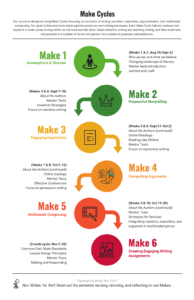Make Cycle 4
 Make Cycle 4: Compelling Arguments
Make Cycle 4: Compelling Arguments
Oct 5-18
For this make cycle, you will create a composition that represents a specific perspective on an issue, and attempts to persuade its intended audience to think, act, or believe in a particular way. Along with narrative and expository writing, persuasive writing (also called argument and opinion writing) is one of the three writing purposes identified in the California and Common Core standards documents. While I do not think any text is that tidy–rarely is a text only expository or argumentative or narrative or whatever–we can gain something by focusing in on the ways texts are composed and looking at components of texts more closely.
Argument writing intends to convince readers that the ideas being conveyed are worthwhile. Arguments are often characterized by their use of what are called appeals to the reader. These are generally classified as appeals to the writer’s expertise and authority, called ethos (“Believe me, I’m an expert!”); appeals to the reader’s emotions, called pathos (“If you don’t act now, these puppies may be euthanized”); and appeals to the reader’s sensibility and logic, called logos (“Supporting the school bond measure won’t help just the schools, but the whole community”). As you think about working to create an argument in this make cycle, think about trying to balance these different appeals.
Make Cycle 4 in a nutshell:
- By Sunday, Oct 11: Response to chapter 4 & 5 and Appendix E from About the Authors (note: no Wednesday response this time just so we can have a bit of a break from the pace)
- By Wednesday, Oct 14: Response to mentor texts
- By Sunday, Oct 18: Make 4 due–Compelling Arguments!
Week 7
For week seven, we’ll read a couple of chapters in our professional book, About the Authors, but just write one post on Sunday: no Wednesday post this week. So, slightly more reading, but one less response this week.
By Sunday, Oct 11:
Read About the Authors: Chapter 4 & 5 and Appendix E
Prompt: You’ve been doing such exceptional work with this professional book. Let’s simply continue on our usual approach: identity some ideas from both chapters that are “take away” ideas for you or interesting or puzzling. Since this is our only post for this week, write an extended post (3-4 paragraphs), perhaps with a couple ideas from chapter 4 and a couple from chapter 5 and Appendix E. I’m thoroughly enjoying your insights into this book; thank you!
Post in Make Cycle 4: Chapters 4 & 5 Discussion
Week 8
By Wednesday, Oct 14:
Read the Make Cycle’s mentor texts below, which include children’s books and educational blogs. (More mentor texts here that support teaching argument; you might want to bookmark for your future classroom.)
- Read: Kim Jaxon’s (that’s me 😉 ) “No Shortcuts in Course Design” (example educational blog) OR watch my Ignite talk where I make an argument for large classes (!):
- Watch: videos below. Children’s books are great models for argumentative writing. I can imagine asking your students to look at the uses of letter writing offered in a number of these books below and then asking students to write their own letters of persuasion about something they need at their school or home or in the community. Or, think about the way Ibram X Kendi’s new children’s book, Antiracist Baby, shares powerful arguments in the form of a rhyming board book. (As you may know, Kendi’s book How to Be an Anti-Racist is the Book in Common for Chico State and Butte College this year. You can find lots of events to participate in virtually if you’re interested here).
Then, write a response to a couple of the mentor texts in which you address the following:
- What craft elements do you notice that the writer of the piece is employing? How can you imagine using those craft elements in your own writing?
- What text features do you notice? Consider elements like graphics, images and captions, and text size/color/placement. Analyze how these elements impact the effectiveness of the argument and its message.
- What do you infer about the author’s point of view and purpose for writing the piece? Analyze the ways the author acknowledges and addresses other perspectives on the issue.
- What information does the text try to convey, and how well does it do so?
- Describe how compelling you find the arguments within the mentor text. Were you convinced? To what extent? Why? What worked best? What seemed weakest?
Post in Make Cycle 4: Ideas for Writing (arguments)
By Sunday, Oct 18:
Make 4: Compelling Arguments!
 Because arguments are ubiquitous, a word which here means they’re in pretty much everything you read, you will have many options for this make. Some possibilities:
Because arguments are ubiquitous, a word which here means they’re in pretty much everything you read, you will have many options for this make. Some possibilities:
- Advice Column: Write an advice column by creating a letter that asks for advice, and then the advice columnist’s response that attempts to convince the letter-writer to do something specific. Advice columns often include resources and facts that will help the original letter-writer better understand the problem they have shared. Twist: Use a common, popular text as the basis for your advice column (maybe the farmer in Click Clack Moo is reaching out for help, or a Disney Princess needs some advice about dating, or Dany Targaryen wants some suggestions for making a good impression with the lords of the North, or … ).
- Advertisement: Create a print, video, or audio advertisement for a product, practice, or idea about teaching. This could be a legitimate, real thing, or something that you’re making up. It could be for a thing that every teacher should have in the classroom, or a technique that teachers could benefit from using, or a stance/mindset about learning that could help teachers be more successful/effective. Have I Got a Book for You! might help you think about the ways advertisements work. Twist: You could make your product be something comical, unrealistic, or outrageous.
- Funding Pitch: Use the basic premise of the advertisement option above, but instead create a crowdfunding proposal (like those found on Kickstarter, or those presented on the TV show Shark Tank) for your brilliant teacher-focused product, practice, or idea. Piktochart has a crowd-funding infographic template that could work for this.
- Letter Writing: Use the letter format to create an argument. A letter to the editor or it could be an exchange of letters back and forth between two (or more) made-up characters to provide perspectives on an issue. Use The Day the Crayons Quit, Click Clack Moo, and/or I Wanna Iguana for inspiration. Feel free to twist this one as well, or course. You could even think about “under appreciated” objects in your life (like the crayons) and write from that perspective. I can imagine my eye glasses writing me a letter about the various places I leave them and how I take them for granted in the style of The Day the Crayons Quit.
- Educational Blog: Argue for a particular idea in education, perhaps using our About the Authors book for inspiration. What do you want parents to know, for example, about teaching writing after reading their book and participating in our class? Here’s a recent blog that I wrote about our current moment in digital course design, but the Connected Learning site and Inside Higher Education overall are interesting examples of educational blogs that you could use for inspiration.
- Children’s Book: Write a children’s book that shows kids how (or how not) to win an argument. Consider using Don’t Let the Pigeon Drive the Bus for this one, and maybe even explain a bit about ethos, pathos, and logos if you’re feeling particularly clever.
- Another idea for a Blog or a short film or vlog: Lots of incredibly serious discussions taking place right now in the world. You could write your own blog encouraging your friends, family, or colleagues to take a stand on an issue that matters to you. Or encourage them to VOTE!
- If you have other ideas for creating compelling arguments, just run them past me.
As always, be sure that you include a reflection that describes what you were intending, identifies the craft elements you included, and references any mentor texts that influenced your work. And comment on each other’s ideas as always!
Post in Make Cycle 4: Compelling Argument Make
 You can find our current Make Cycles in the drop down menu and on the
You can find our current Make Cycles in the drop down menu and on the